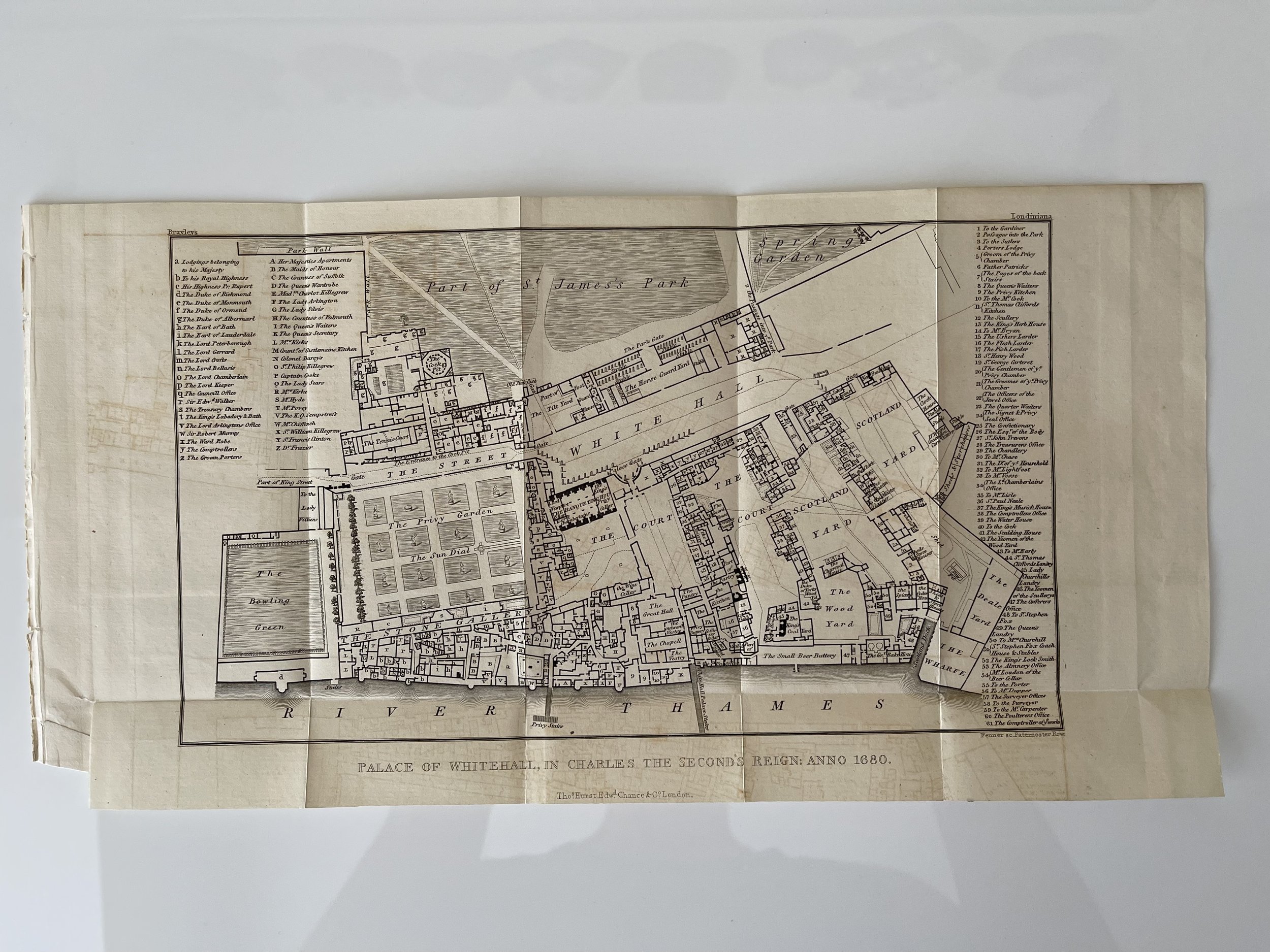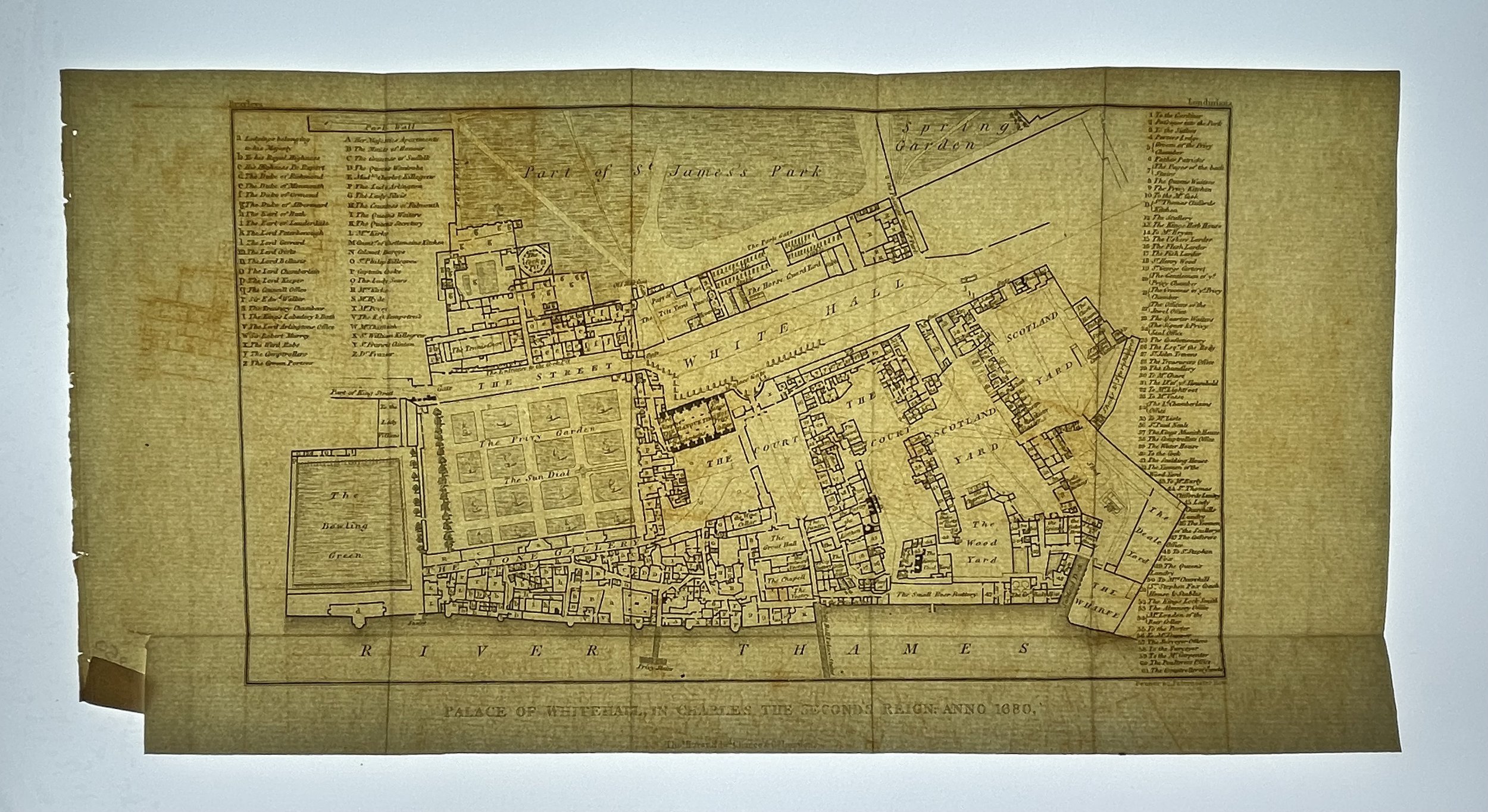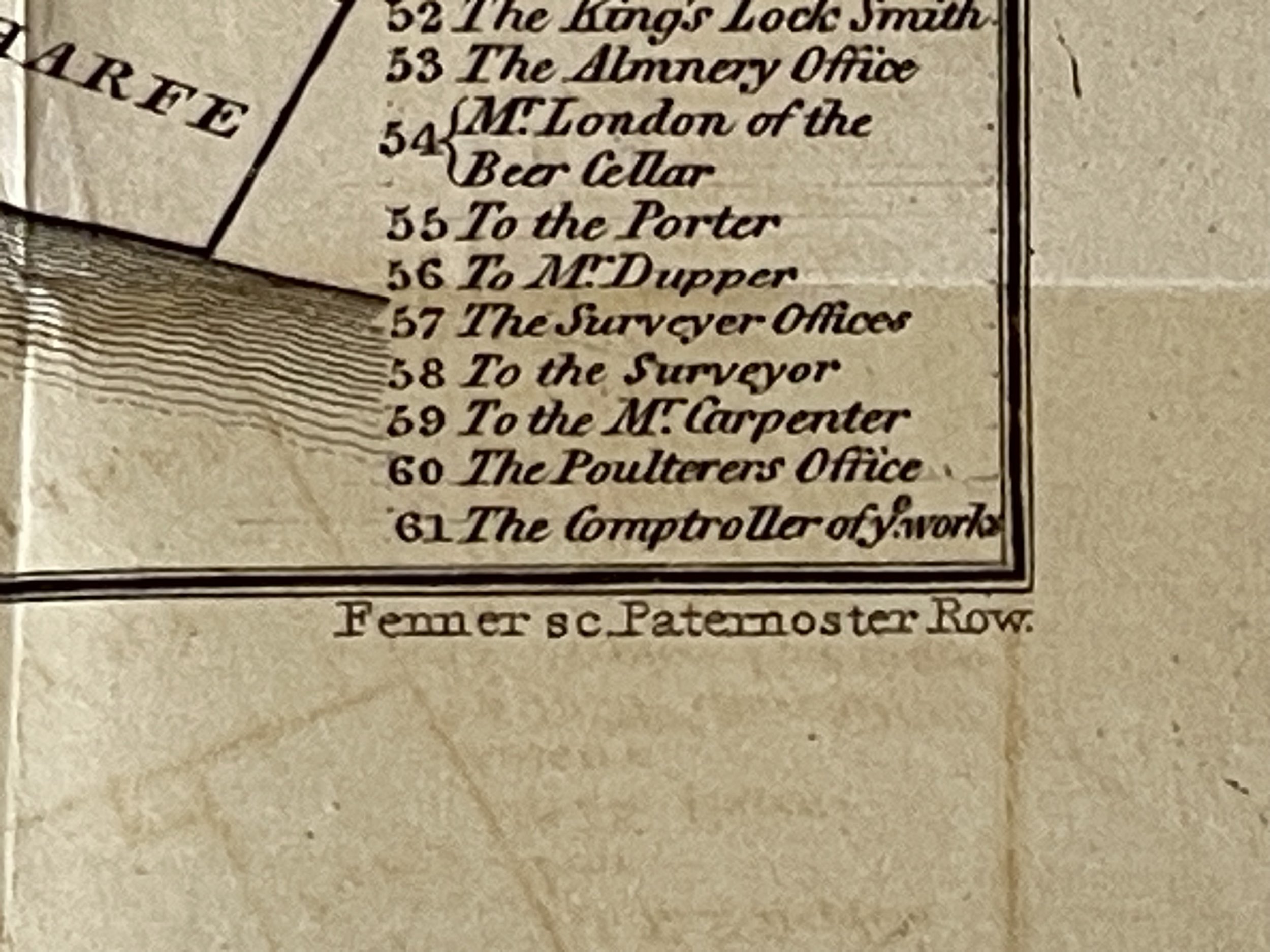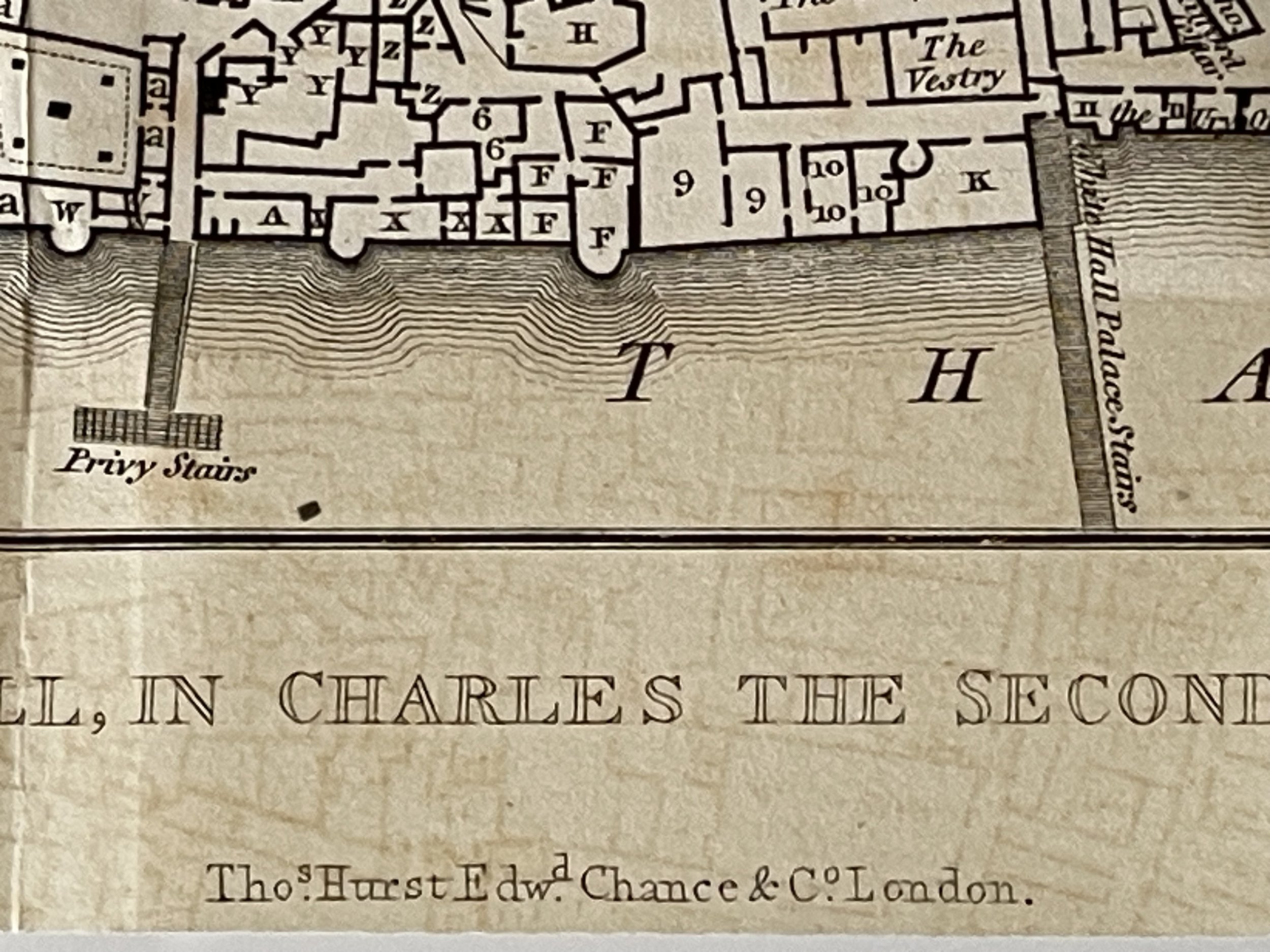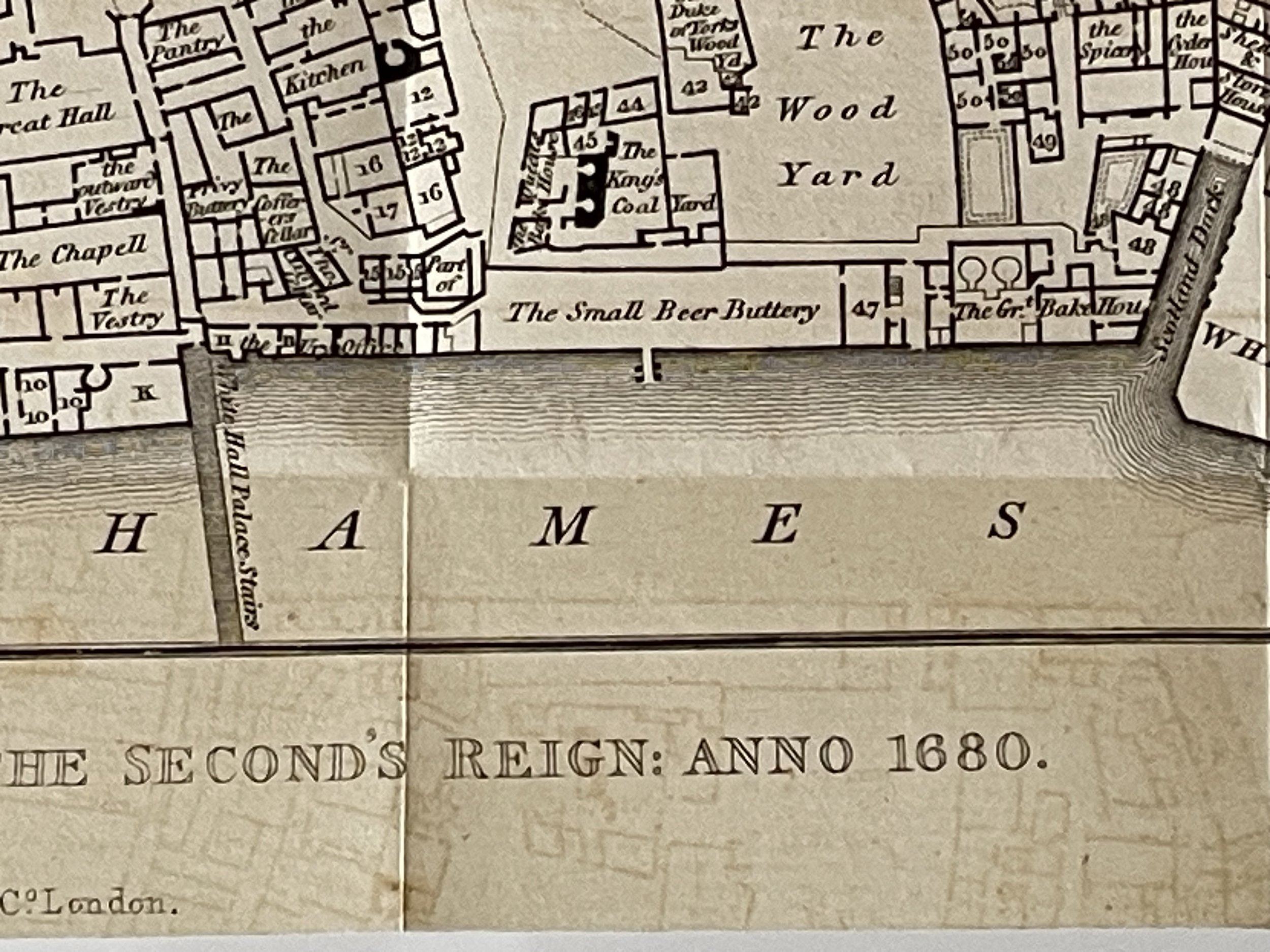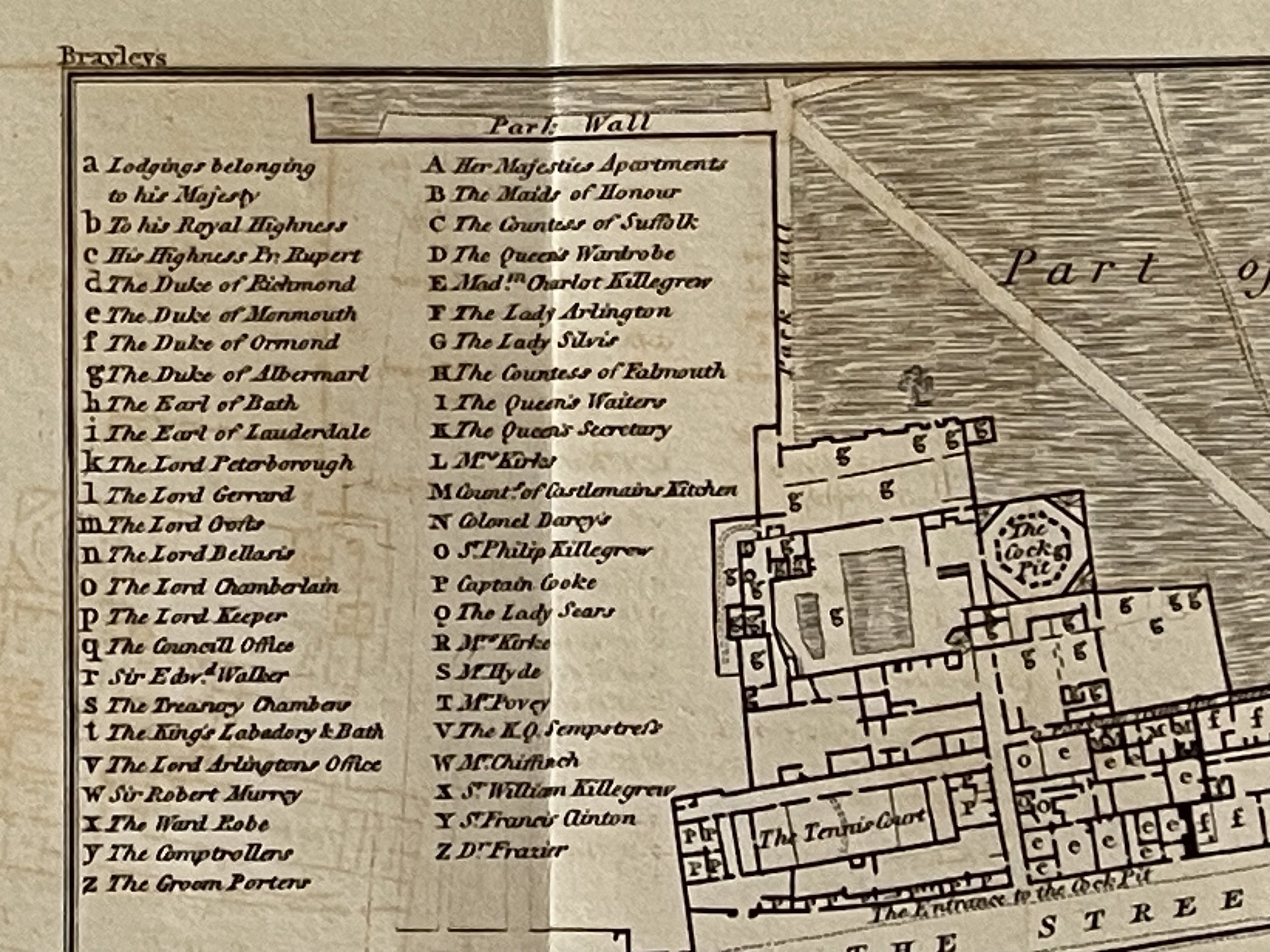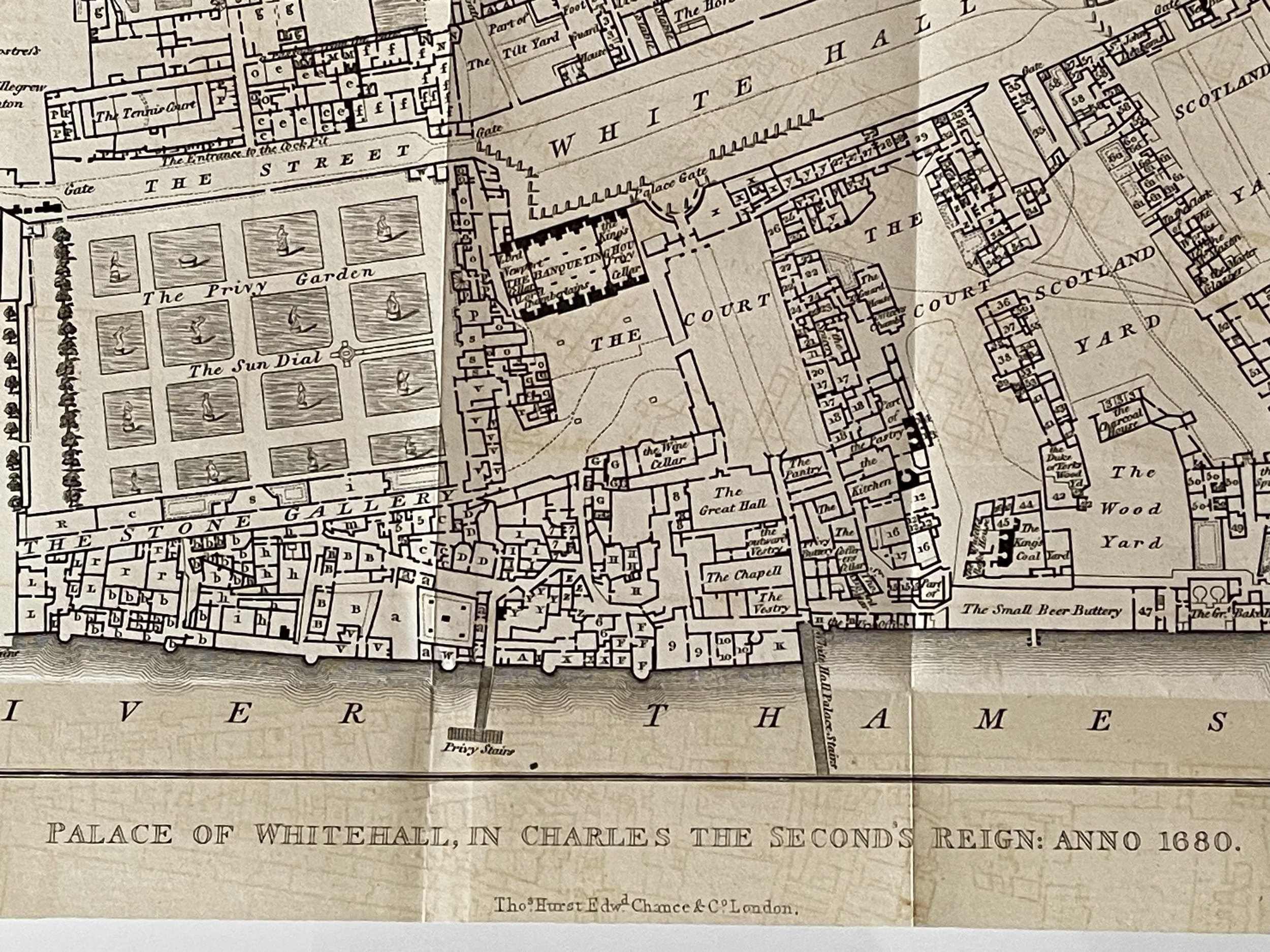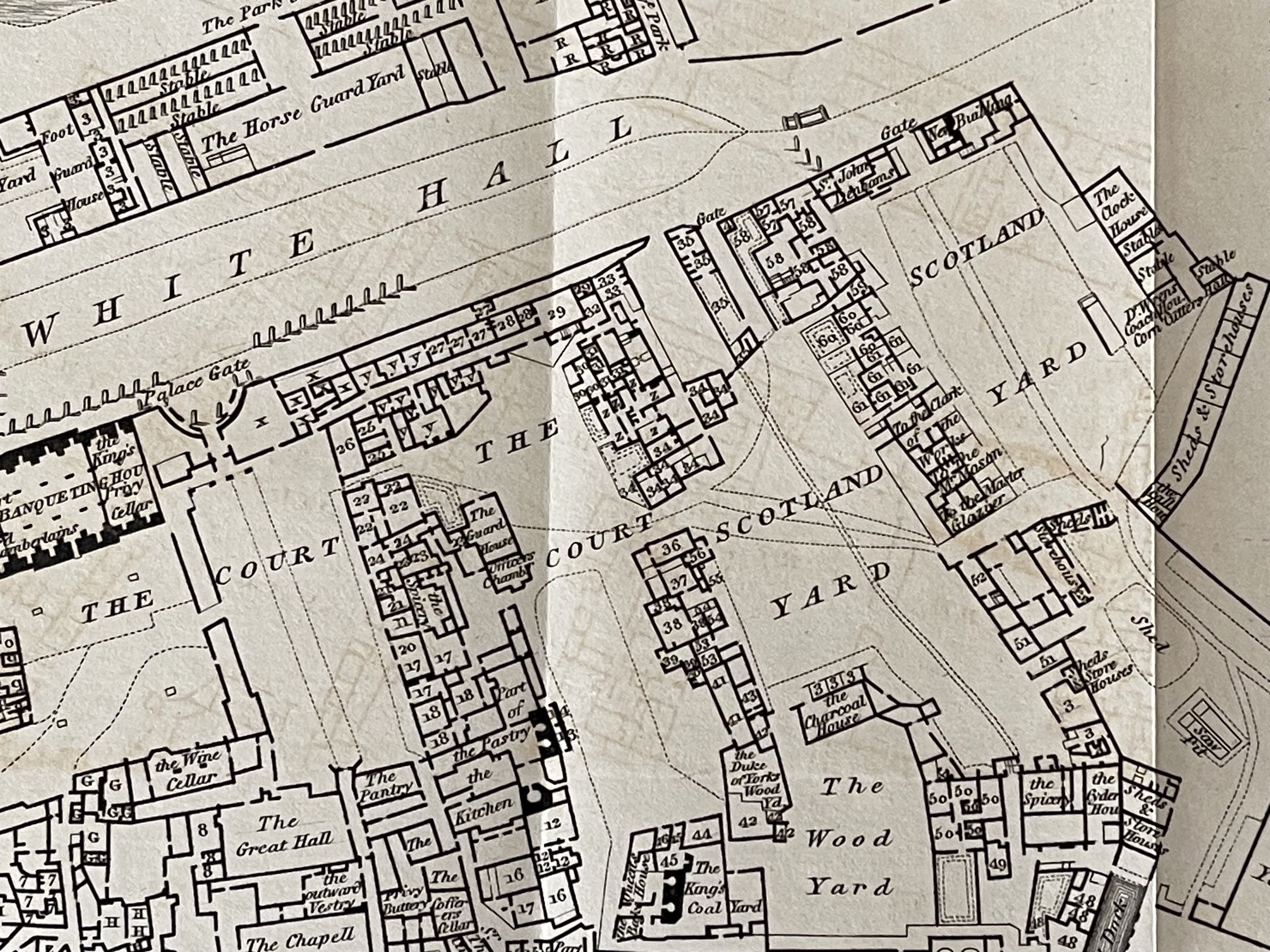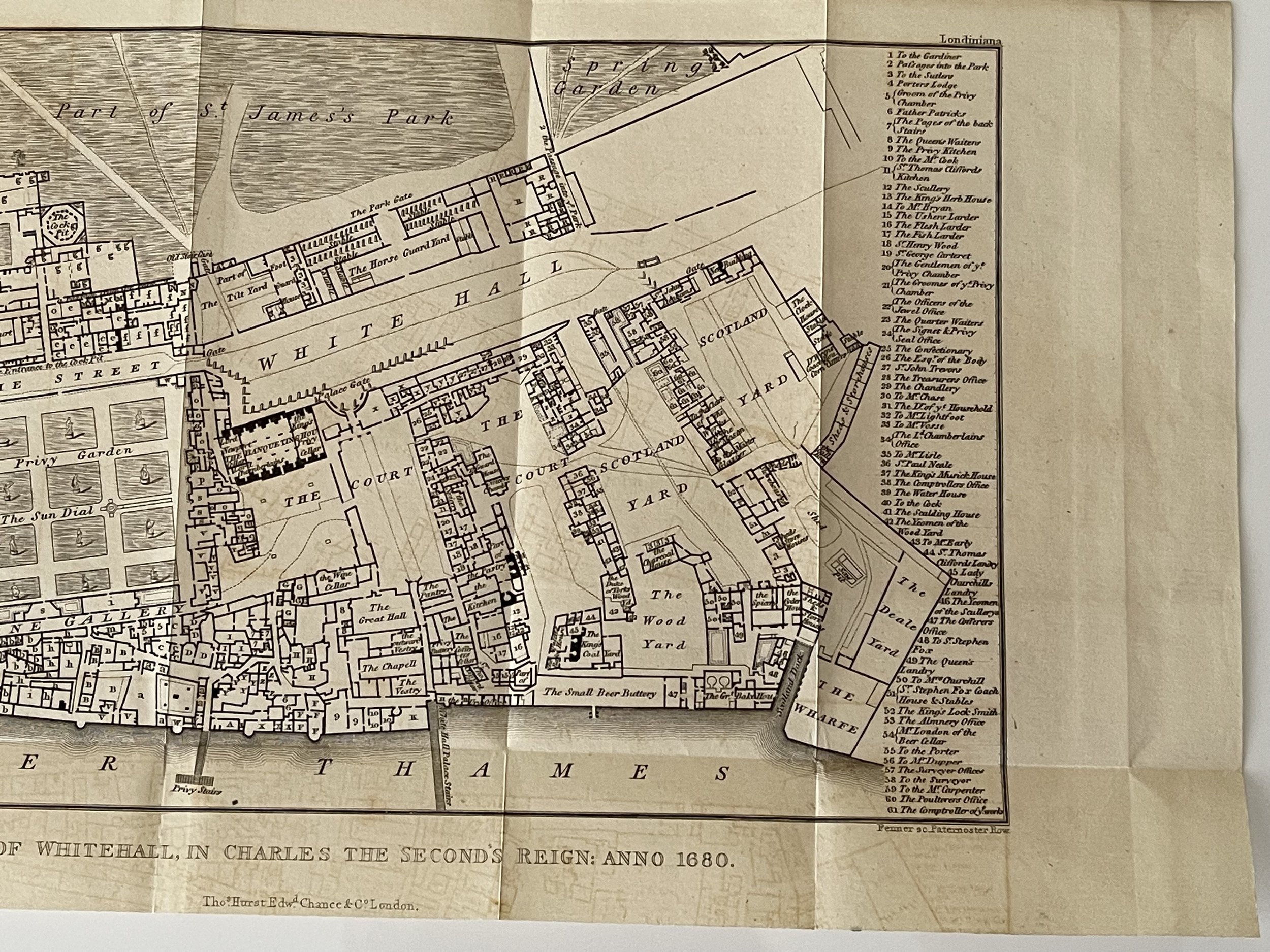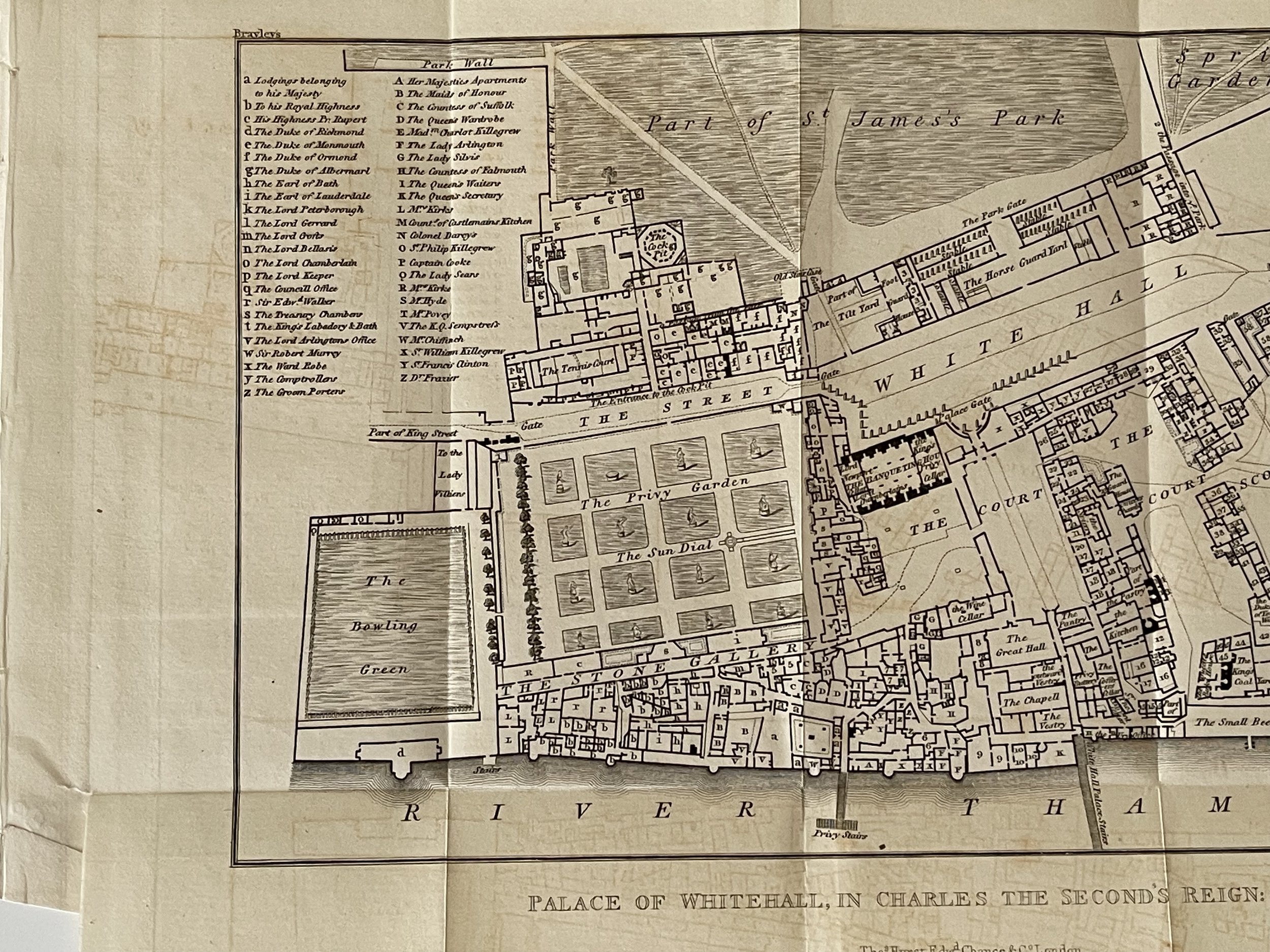Palace of Whitehall London During the Reign of Charles II - Edward Wedlake Brayley 1829
Palace of Whitehall 1680. London Old plan Edward Wedlake Brayley 1829
Title: Palace of Whitehall, in Charles the second’s Reign Anno 1680.
Description: Old antique ground plan of castle Whitehall with annotations.
By the 13th century, the Palace of Westminster had become the centre of government in England, and had been the main London residence of the King since 1049.
The name Whitehall or White Hall was first recorded in 1532; it had its origins in the white stone used for the buildings.
Edward Wedlake Brayley FSA (1773 – 23 September 1854)
Was an English historian and topographer. Brayley collaborated with his life-long friend, John Britton, on the first 6 volumes of The Beauties of England and Wales. Brayley was born at Lambeth, Surrey. He was apprenticed to the enamelling trade but developed an early interest in literature.
After completing his apprenticeship, Brayley was employed by Henry Bone (later a Royal Academician) to prepare and fire enamelled plates for small pictures in rings and trinkets. Later, when Bone was working on some exceptionally large enamels, Brayley prepared the plates for Bone's use and fired the finished pictures, continuing to do so for some years after he had become eminent as a topographer.
His close friendship with John Britton lasted for sixty-five years. They entered a literary partnership, and after minor success with songs and plays, they became joint editors of The Beauties of England and Wales, themselves writing many of the volumes.
Having reached an agreement with a publisher, in 1800 Britton and Brayley set off from London through several English counties and visited every county of North Wales in search of materials for the work. The first volume appeared in 1801, and contained descriptions of Bedfordshire, Berkshire, and Buckinghamshire. Accounts of the other counties followed in alphabetical order. The first six volumes, ending with Herefordshire, were jointly executed by Brayley and Britton, the greater part of the text being supplied by Brayley, while Britton did most of the travelling, correspondence, collecting of books and documents, and dealt with the illustrators and engravers.
Although originally it had been announced that it would be in about six volumes, and finished within three years, The Beauties of England and Wales eventually extended to twenty-five large volumes, published over nearly twenty years. Disagreements between the writers and publishers led to Britton and Brayley's withdrawal from the project, and Brayley's name does not appear in any volumes published after the description of London.
In 1823 he was elected a fellow of the Society of Antiquaries, and he was appointed librarian and secretary of the Russell Institution in Great Coram Street in 1825, remaining in the positions until his death. He died in London on 23 September 1854.
Palace of Whitehall 1680. London Old plan Edward Wedlake Brayley 1829
Title: Palace of Whitehall, in Charles the second’s Reign Anno 1680.
Description: Old antique ground plan of castle Whitehall with annotations.
By the 13th century, the Palace of Westminster had become the centre of government in England, and had been the main London residence of the King since 1049.
The name Whitehall or White Hall was first recorded in 1532; it had its origins in the white stone used for the buildings.
Edward Wedlake Brayley FSA (1773 – 23 September 1854)
Was an English historian and topographer. Brayley collaborated with his life-long friend, John Britton, on the first 6 volumes of The Beauties of England and Wales. Brayley was born at Lambeth, Surrey. He was apprenticed to the enamelling trade but developed an early interest in literature.
After completing his apprenticeship, Brayley was employed by Henry Bone (later a Royal Academician) to prepare and fire enamelled plates for small pictures in rings and trinkets. Later, when Bone was working on some exceptionally large enamels, Brayley prepared the plates for Bone's use and fired the finished pictures, continuing to do so for some years after he had become eminent as a topographer.
His close friendship with John Britton lasted for sixty-five years. They entered a literary partnership, and after minor success with songs and plays, they became joint editors of The Beauties of England and Wales, themselves writing many of the volumes.
Having reached an agreement with a publisher, in 1800 Britton and Brayley set off from London through several English counties and visited every county of North Wales in search of materials for the work. The first volume appeared in 1801, and contained descriptions of Bedfordshire, Berkshire, and Buckinghamshire. Accounts of the other counties followed in alphabetical order. The first six volumes, ending with Herefordshire, were jointly executed by Brayley and Britton, the greater part of the text being supplied by Brayley, while Britton did most of the travelling, correspondence, collecting of books and documents, and dealt with the illustrators and engravers.
Although originally it had been announced that it would be in about six volumes, and finished within three years, The Beauties of England and Wales eventually extended to twenty-five large volumes, published over nearly twenty years. Disagreements between the writers and publishers led to Britton and Brayley's withdrawal from the project, and Brayley's name does not appear in any volumes published after the description of London.
In 1823 he was elected a fellow of the Society of Antiquaries, and he was appointed librarian and secretary of the Russell Institution in Great Coram Street in 1825, remaining in the positions until his death. He died in London on 23 September 1854.
Palace of Whitehall 1680. London Old plan Edward Wedlake Brayley 1829
Title: Palace of Whitehall, in Charles the second’s Reign Anno 1680.
Description: Old antique ground plan of castle Whitehall with annotations.
By the 13th century, the Palace of Westminster had become the centre of government in England, and had been the main London residence of the King since 1049.
The name Whitehall or White Hall was first recorded in 1532; it had its origins in the white stone used for the buildings.
Edward Wedlake Brayley FSA (1773 – 23 September 1854)
Was an English historian and topographer. Brayley collaborated with his life-long friend, John Britton, on the first 6 volumes of The Beauties of England and Wales. Brayley was born at Lambeth, Surrey. He was apprenticed to the enamelling trade but developed an early interest in literature.
After completing his apprenticeship, Brayley was employed by Henry Bone (later a Royal Academician) to prepare and fire enamelled plates for small pictures in rings and trinkets. Later, when Bone was working on some exceptionally large enamels, Brayley prepared the plates for Bone's use and fired the finished pictures, continuing to do so for some years after he had become eminent as a topographer.
His close friendship with John Britton lasted for sixty-five years. They entered a literary partnership, and after minor success with songs and plays, they became joint editors of The Beauties of England and Wales, themselves writing many of the volumes.
Having reached an agreement with a publisher, in 1800 Britton and Brayley set off from London through several English counties and visited every county of North Wales in search of materials for the work. The first volume appeared in 1801, and contained descriptions of Bedfordshire, Berkshire, and Buckinghamshire. Accounts of the other counties followed in alphabetical order. The first six volumes, ending with Herefordshire, were jointly executed by Brayley and Britton, the greater part of the text being supplied by Brayley, while Britton did most of the travelling, correspondence, collecting of books and documents, and dealt with the illustrators and engravers.
Although originally it had been announced that it would be in about six volumes, and finished within three years, The Beauties of England and Wales eventually extended to twenty-five large volumes, published over nearly twenty years. Disagreements between the writers and publishers led to Britton and Brayley's withdrawal from the project, and Brayley's name does not appear in any volumes published after the description of London.
In 1823 he was elected a fellow of the Society of Antiquaries, and he was appointed librarian and secretary of the Russell Institution in Great Coram Street in 1825, remaining in the positions until his death. He died in London on 23 September 1854.
Code : A250
Cartographer : Cartographer / Engraver / Publisher: Edward Wedlake Brayley
Date : Publication Place / Date - Circa 1829
Size : Sheet size: Image Size: 34.5 x 18 cm
Availability : Available
Type - Genuine - Antique
Grading A+
Where Applicable - Folds as issued. Light box photo shows the folio leaf centre margin hinge ‘glue’, this is not visible otherwise.
Tracked postage, in casement. Please contact me for postal quotation outside of the UK.
